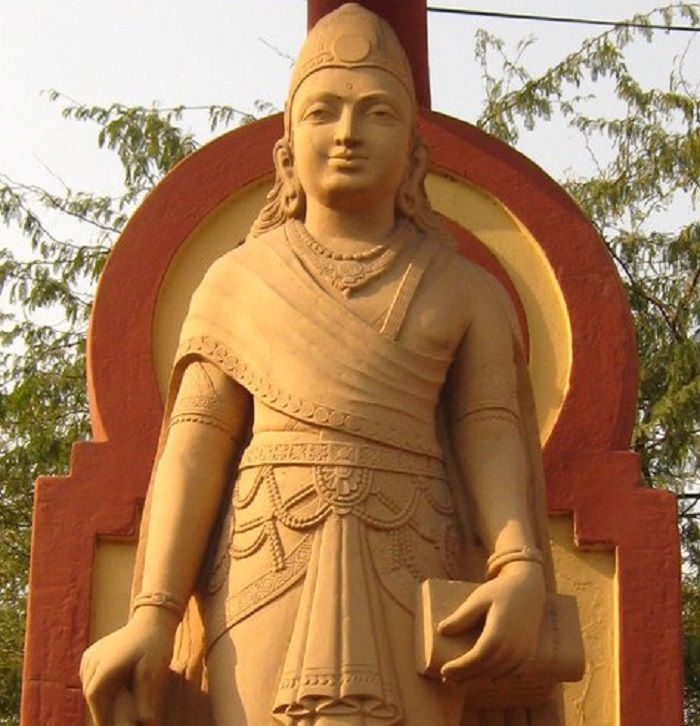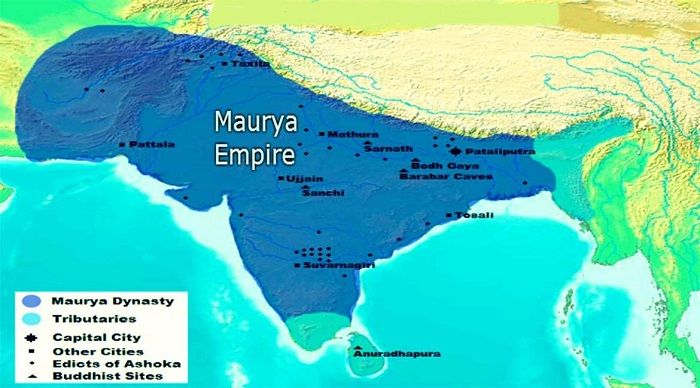Founded by Chandragupta Maurya, the Mauryan Empire dominated ancient India from 322 BCE to 187 BCE. It became one of the largest empires of its time. The capital city of the empire was at Pataliputra (now Patna,) and the empire extended across Magadha in the Indo-Gangetic Plan towards the east. At its zenith under the reign of Ashoka, the Mauryan Empire spanned over five million square kilometres, making it the largest empire in the Indian subcontinent that ever existed.
All the economic activities, including external and internal trade and agriculture bloomed. The credit for this goes to the single and methodical system of security, finance and administration. During the reign of Ashoka, after the Kalinga War, the Mauryan Empire sustained peace and security for approximately half a century. A long period of religious transformation, expansion of knowledge and sciences and social harmony was also enjoyed in the Mauryan Empire.
Chandragupta Maurya converted to Jainism. Similarly, Buddhism was embraced by Ashoka that resulted in non-violence, political and social peace across the empire. Buddhist missionaries were also sent to Mediterranean Europe, Southeast Asia, North Africa, Sri Lanka and West Asia by Askhoka.
With an estimated population of more than 55 million, the Mauryan Empire was one of the most populous empires. The primary sources of written records of Mauryan times are the Edicts of Ashoka and the Arthashstra.
History of the Maurya Empire
Chandragupta Maurya founded the Mauryan Empire with the help of Chanakya. Chandragupta’s rise to power is surrounded in controversy and mystery. The throne of Magadha was seized by Chandragupta Maurya from the last Nanda king. He then moved to conquer the northern India that was beyond the Magadha borders. Alexander’s successors were driven out by Chandragupta from the western region and he went ahead to extend his reach towards eastern Iraq and Afghanistan. Chandragupta Maurya laid the foundation of a robust and efficient central government. Chanakya, his highly capable chief minister, played a prominent in achieving this with the help of his intelligence network.
Chandragupta Maurya’s son Bindusara succeeded him and reigned from 298-272 BCE. Bindusara continued to extend the Mauryan Empire by conquering central India. Unlike Chandragupta, who was an ardent believer of Jainism, Bindusara was a follower of Ajivika sect. His guru was a Brahmin and so was his wife. He is accredited with providing a number of grants to Brahmin monasteries, also known as Brahmana-bhatto.
Bindusara was succeeded by his son Ashoka, who ruled from 272 to 232 BCE. He is recognized as one of the most remarkable and brilliant commanders not only in the history of India but also across the globe. He re-asserted the Empire’s superiority in western and southern India. He was an aggressive as well as an ambitious monarch. The most significant political event of Ashoka’s life was his conquest of Kalinga.
Although he was able to expand his empire after a bloody Kalinga war, the bloodshed and sufferings of people forced him to renounce warfare and embrace Buddhism. Thereafter, he decided to rule by ‘Bhamma’ and sent out missionaries to spread the message of peace and non-violence. The principles of ahimsa were implemented by Ashoka by banning violent sports activity and hunting. A powerful and large army was maintained by him to ensure peace and authority. Friendly relations were expanded with states across Europe and Asia. Buddhist missions were also sponsored by him. He became one of the most famous monarchs in the history of India with more than half a century reign of harmony, peace and prosperity.
Edicts of Ashoka can be found across the subcontinent, from Afghanistan to Andhra. His policies and accomplishments are stated in his edicts, spread across several parts of India.
Natural History
The Mauryans were the first ones to provide a unified political entity in the country.
Forests were viewed as resources by the Mauryas. The elephant was regarded as the most significant forest product. They were used in battles, since it was cheaper to catch, tame and train the wild elephants for warfare.
Separate forests were designated by the Mauryas in order to protect lions and tigers for skin. This was also done to eliminate theft and make woods safe for grazing animals.
The forest tribes were seen with distrust and were controlled with political subjugation and bribery. Some of them were employed to trap and guard animals while some were employed as food-gatherers.
During the reign of Ashoka, significant changes were made in the style of governance. The royal hunt was discontinued and special emphasis was laid on protecting the fauna. He became the first ruler who not only advocated conservation measures but also got the rules pertaining to that inscribed on stone edicts.

Image Credit : https://www.ancient.eu/Mauryan_Empire/
Mauryan Administration
The imperial capital of the Mauryan Empire was at Pataliputra and the empire was categorized into four territories. According to tThe Ashokan edicts, the four provincial capitals were Taxila, Ujjain, Tosali and Suvarnagiri. Kumara or the royal prince was the chief of the provincial administration. He served as king’s representative and governed the provinces. The council of ministers and Mahamatyas served as assistants to the kumara. The same organizational structure was seen at the imperial level that consisted of the Emperor and his Council of Ministers or the Mantriparishad.
As described by the Kautilya in the Arthashastra, the administrative organisation of the Empire was in sync with the bureaucracy. Historians theorise that municipal hygiene to international trade was all governed by a sophisticated civil service. The defence and expansion of the empire is accredited to the army, regarded as the largest army during the Iron Age. Going by Megasthenes, the empire commanded a military of thirty-thousand cavalry, nine thousand war elephants, six lakh infantry and eight thousand chariots, besides numerous attendants and followers. A vast surveillance system helped in gathering intelligence for both external and internal security.
Though Ashoka renounced warfare, he continued to maintain his large army in order to instil peace and stability across his Empire.
Achievements
It was during the Mauryan Empire that the military security and political unity in South Asia allowed for a collective economic system that resulted in enhancing trade and commerce. The agricultural productivity also increased. There was a disciplined central authority and farmers were freed of crop collection burdens and tax from regional kings. The farmers instead paid tax to a strict yet fair nationally administered system as devised by the principles mentioned in the Arthashastra. A single currency across India was established by Chandragupta Maurya. Justice and security for farmers, traders and merchants was secured by a well-laid out network of administrators and regional governors.
A number of powerful chieftains, gangs of bandits and regional private armies who tried to impose their own supremacy in small areas were wiped out by the Mauryan army. The revenue collection was systematized, and a number of public works and waterways were commissioned. The new found internal peace and political unity resulted in expanding the internal trade.
The exports of the country comprised of exotic foods, silk goods, spices and textile. The exchange of technology and scientific knowledge with West Asia and Europe further enriched the Empire.
The construction of hospitals, roads, canals, rest-houses, waterways and other public works were also sponsored by Ashoka.

Image Credit : https://www.pinterest.com/pin/485544403560820353/?lp=true
Decline of the Mauryan Empire
Approximately half a century after the demise of Ashoka, the great Mauryan Empire began to crumble. By the mid-2nd century BCE the empire shrunk to its core areas with outlying provinces falling apart. The primary cause of the decline of the great Empire was successive weak rulers after the death of Ashoka. The vastness of the empire, internal revolts, and foreign invasions are some of the few other factors that resulted in the decline of the Mauryan Empire.
Interesting Facts about the Mauryan Empire
- The Lion Capital of Ashoka at Sarnath is the national emblem of India.
- The Mauryan Empire grew and thrived during the Iron Age.
- Some friendly kingdoms not annexed to the Mauryan Empire were the Pandyas, Cheras and Cholas.
- At its zenith, the Mauryan Empire was not only the largest empire in the history of the country but also across the globe.
- Sources reveal that Chandragupta Maurya and Chanakya built an alliance with the Himalayan King Parvataka, often identified with Porus.
- The Mauryan Empire is regarded as the country’s first centralized power; its administration was extremely efficient.
- The Mauryan army was one of the largest armies across the globe. It was well-trained and a pro at using several formations at the battlefield.
- Chanakya and Chandragupta Maurya are credited with standardizing weights and measures.
- Chandragupta established a system of a single currency across his empire.


